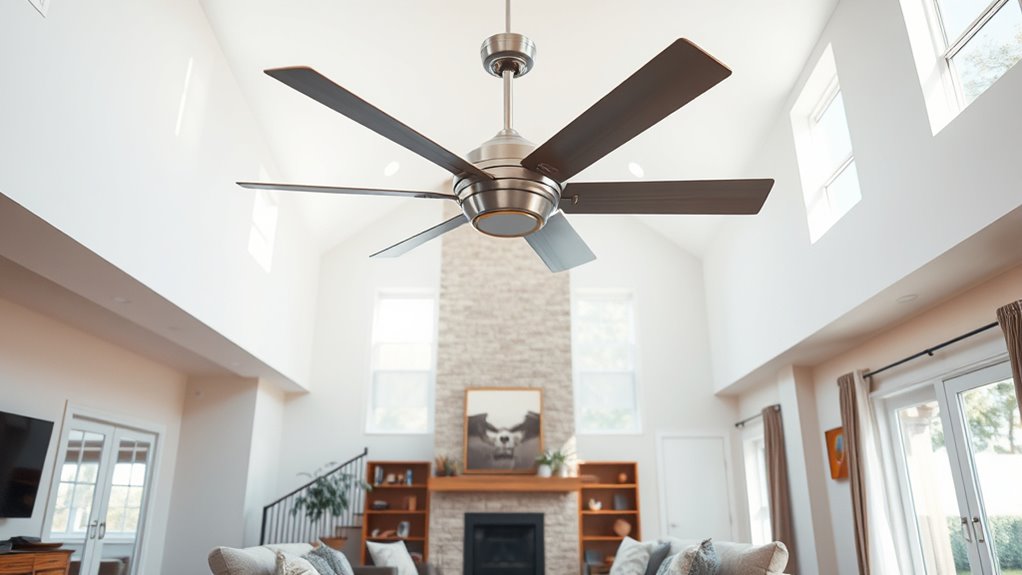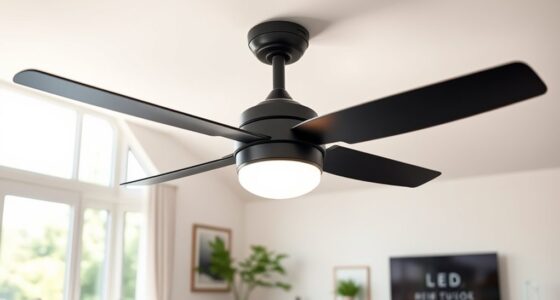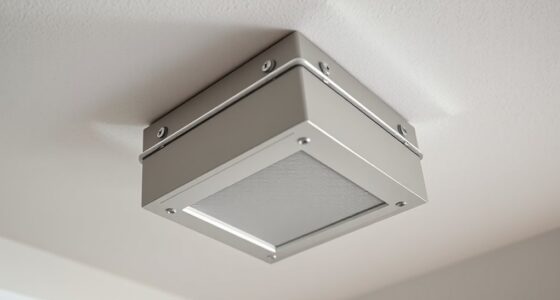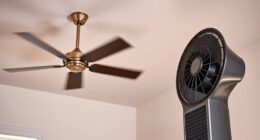To select the right ceiling fan size, first measure your room’s length and width accurately, then calculate the square footage. Match the fan blade span to your room size: about 29-36 inches for small rooms, 42-48 inches for medium, and over 52 inches for large spaces. Also, consider ceiling height and proper clearance to guarantee safe, efficient airflow. Keep these tips in mind, and you’ll find the perfect fan for your space. To learn more, keep exploring the details behind each step.
Key Takeaways
- Measure your room’s length and width accurately to determine the total square footage.
- Match the fan’s blade span to your room size: smaller for 75 sq. ft., larger for over 350 sq. ft.
- Consider ceiling height; use longer downrods for high or vaulted ceilings to ensure proper blade clearance.
- Ensure at least 12 inches of clearance between blades and walls for optimal airflow.
- Choose a fan style and size that complements your room’s decor while providing effective air circulation.
Measure Your Room’s Dimensions Accurately
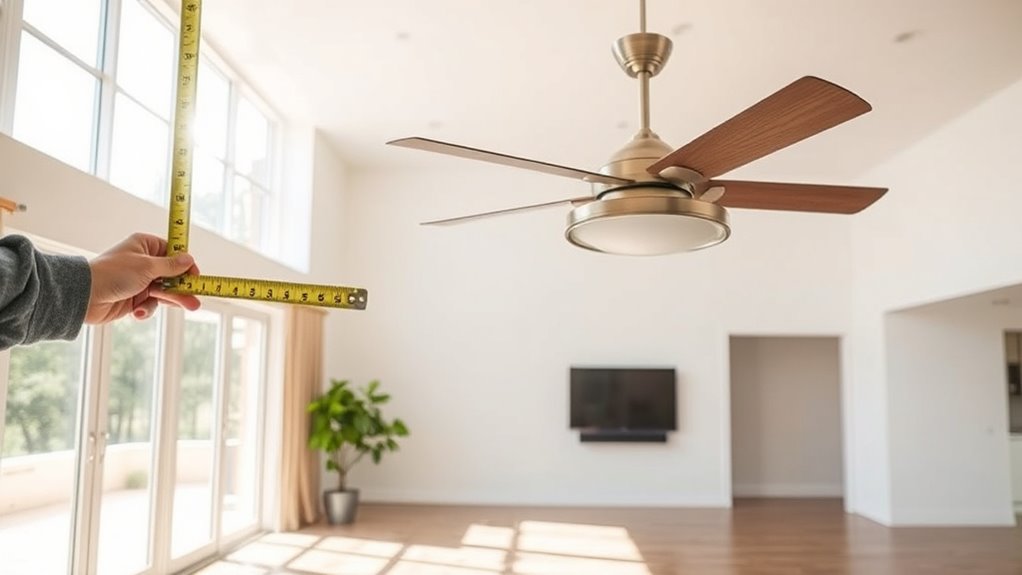
To choose the right ceiling fan size, you need to measure your room’s dimensions accurately. Use a measuring tape to determine the room’s length and width in feet, measuring straight from wall to wall along the floor. For irregularly shaped rooms, divide the space into smaller rectangles, measure each separately, then add their areas to find the total square footage. Multiply the length by the width to calculate your room size, which guides your fan size choice. Ensure your measuring tape stays taut and straight to get accurate measurements. Record each dimension carefully to avoid errors. Precise measurements are essential for effective space calculation, helping you select a ceiling fan that fits your room shape and square footage perfectly, ensuring ideal airflow and aesthetic harmony. Additionally, understanding the appropriate fan size for your room ensures optimal comfort and energy efficiency. Considering vertical storage solutions and clutter reduction can also create a more spacious environment that complements your new fan setup. Properly sized fans can also contribute to energy savings, making your space both comfortable and cost-effective.
Determine the Appropriate Fan Blade Span

To choose the right fan blade span, you need to measure the diameter of the blades from tip to tip accurately. Match the blade span to your room size for effective airflow and balanced aesthetics. Keep in mind that blade style and number can also influence airflow and the overall look. Additionally, selecting a fan with a professional maintenance feature or access to expert repair services can ensure long-term performance and safety. Proper installation and considering aesthetic wall organization can further enhance the room’s decor and functionality. When selecting a fan, consider the room’s decor style to ensure the fan complements your farmhouse bedroom’s rustic charm. It’s also helpful to understand fan size guidelines to make an informed decision that maximizes comfort and efficiency.
Measure Fan Diameter Carefully
Measuring the fan diameter accurately is essential for choosing the right size. To measure fan size, record the blade span from tip to tip across the fully assembled fan. Proper measurement ensures that the fan will effectively circulate air in your space. For even-blade fans, measure between two opposite blades. For odd-blade fans, measure from a blade tip to the fan center and double that. Use a tape measure to ensure your ceiling fan measurement aligns with your room size—42-48 inches for spaces up to 175 sq. ft., and 52 inches or more for larger rooms over 350 sq. ft. Accurate measurement of fan size prevents mismatched proportions and ensures optimal performance and aesthetic balance in your space. Proper airflow depends on an accurate fan diameter calculation, which affects airflow efficiency and prevents the fan from appearing too small or overwhelming. Additionally, understanding fan blade design can influence airflow and noise levels. Knowing the room dimensions helps in selecting the best fan size for comfort and effectiveness. Following your fan size guide helps ensure your fan complements the room’s square footage and provides ideal comfort.
Match Fan to Room Size
Choosing the right fan size involves matching the blade span to your room’s dimensions. To do this effectively, measure your room’s length and width, then multiply to find the square footage. Use a fan size guide to select the appropriate blade span:
| Room Size (sq. ft.) | Recommended Fan Diameter (inches) |
|---|---|
| Up to 75 | 29-36 |
| 75-175 | 42-48 |
| 175-350 | 52-56 |
| Over 350 | 60+ |
Ensure the fan’s blade span visually fits your room layout, promoting ideal circulation and airflow. Remember, ceiling height also influences fan choice, so consider both room size and ceiling height for balanced aesthetics and efficient cooling. Proper fan installation can enhance airflow and room comfort.
Consider Blade Style and Number
While selecting the right fan size is essential, paying attention to blade style and number can enhance both function and aesthetics. The blade style and number directly impact airflow and decorative appearance. Consider these points:
- A larger blade span suits bigger rooms, but the blade shape and material also influence airflow and fan performance.
- Fewer, larger blades (like three) typically generate more airflow than many smaller blades, boosting efficiency.
- Intricately styled or more numerous blades add aesthetic appeal but may reduce airflow efficiency.
- Reversible blades allow you to switch finishes, enhancing your room’s decor without sacrificing performance.
Matching blade size and style to your room’s dimensions and decor ensures perfect fan performance and a cohesive look.
Match Fan Size to Room Square Footage

Matching the right ceiling fan size to your room’s square footage is essential for effective airflow and a balanced look. The correct ceiling fan size depends on your room measurement to guarantee a proper fit. For rooms up to 75 sq. ft., choose fans with a blade span of 29-36 inches. Rooms between 75 and 175 sq. ft. need fans measuring 42-48 inches in diameter. For spaces from 175 to 350 sq. ft., opt for fans with a blade span of 52-56 inches. Larger rooms over 350 sq. ft. require fans with a blade span of 60 inches or more to promote ideal air circulation. Ensuring the right fan size also contributes to optimal energy efficiency, as properly sized fans can reduce the need for additional cooling or heating. Additionally, selecting the right fan size can prevent excessive noise and wobbling, enhancing comfort. and improve overall air distribution in your space. Selecting the appropriate fan size can also enhance the aesthetic appeal of your room, creating a cohesive and stylish environment. Matching fan size to room square footage ensures the right fan diameter for your space, maximizing airflow and creating a harmonious aesthetic.
Consider Ceiling Height and Fan Clearance
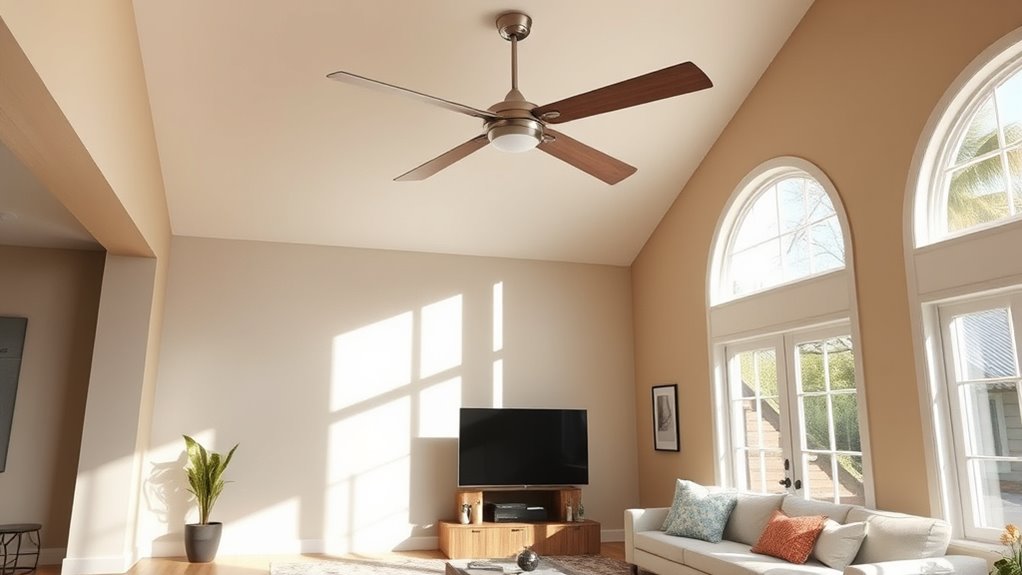
Ceiling height plays a crucial role in guaranteeing your fan operates safely and efficiently. Proper fan clearance prevents hazards and maximizes airflow. To achieve this, consider:
- Maintaining at least 7 feet of clearance between the ceiling fan blades and the floor for safety and ideal airflow.
- Using a longer downrod in rooms with high ceilings to hang the fan lower and enhance circulation. Ensuring the correct fan size is also essential for optimal performance.
- Ensuring the blade distance from walls is at least 12 inches to avoid airflow obstruction.
- For ceilings over 8 feet, selecting the right downrod length based on ceiling height helps position the fan at the suitable ceiling fan height.
Additionally, understanding proper installation techniques can assist in choosing the correct fan size and accessories for your room. Accurate clearance measurement and appropriate downrod use ensure safe ceiling fan installation and excellent performance in any room size or ceiling height. Proper installation techniques are essential for optimal operation and safety.
Select the Correct Downrod Length and Placement
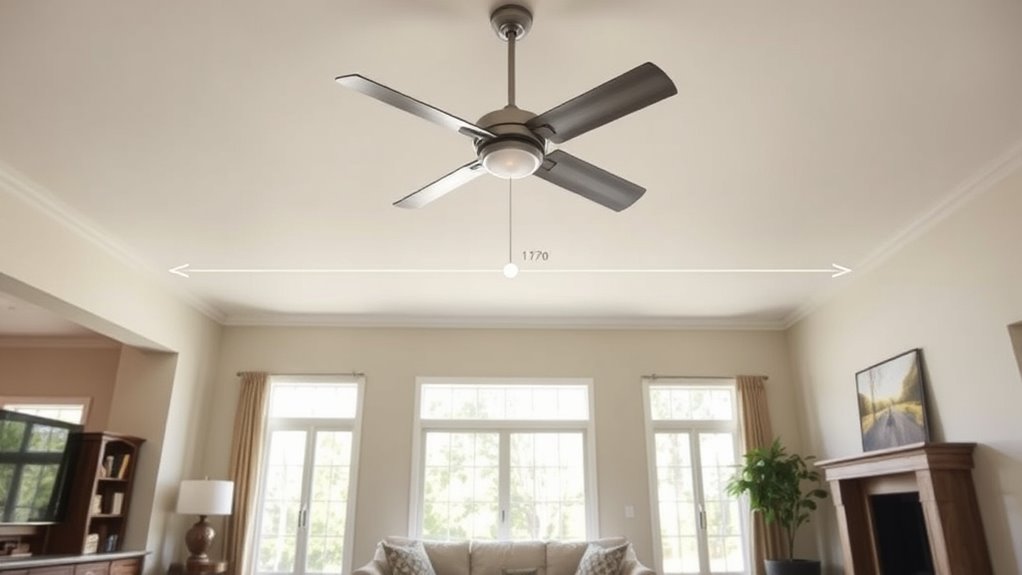
Choosing the right downrod length is essential to guarantee your ceiling fan functions safely and efficiently. Measure your ceiling height and select a downrod that positions the fan blades 8-9 feet above the floor for optimal airflow and safety. Use this chart to guide your selection:
| Ceiling Height | Recommended Downrod Length |
|---|---|
| 8 feet | 3-4 inches |
| 9-12 feet | 12-24 inches |
| Vaulted ceilings | Longer as needed |
| Room size | Larger rooms may need bigger fans for better air circulation |
Proper fan placement ensures the blades are at least 12 inches from the ceiling, preventing wobbling and maximizing airflow, which is critical for effective air circulation and overall installation success. Additionally, considering airflow efficiency can help optimize cooling performance and energy savings.
Factor in Room Function and Aesthetic Preferences

Considering your room’s function and aesthetic preferences is essential when selecting a ceiling fan, as these factors influence both style and performance. Your choice should reflect the room decor and interior style to achieve design harmony.
To guide you:
- Match fan style and finish to your room’s decor—rustic fans suit farmhouse interiors, while sleek modern designs complement contemporary spaces.
- Consider the room function—quiet, aesthetic fans work well in bedrooms; larger, bold fans suit living rooms as focal points.
- Match blade span and style to the room size and layout to enhance the space without overpowering it.
- Select lighting features and control options that align with your aesthetic preferences, such as minimalistic remotes or decorative pull chains.
These choices ensure your fan complements both your room’s function and aesthetic.
Frequently Asked Questions
Is a 52 Inch Fan Too Big for a 12X12 Room?
A 52-inch fan isn’t too big for a 12×12 room; it actually fits well within the recommended size for that space. You’ll notice it provides a good, widespread breeze, especially if your ceilings are high or the layout is open.
While it might seem slightly larger than standard, it still offers proper airflow and looks proportionate. Making it a great choice for enhancing comfort and style in your room.
What Is the Rule of Thumb for Ceiling Fans?
The rule of thumb for ceiling fans is simple yet essential. You match the fan size to your room’s dimensions: small rooms under 75 sq. ft. need fans with 29-36 inch blades, while larger spaces require bigger fans.
This guarantees ideal airflow, comfort, and style. So, instead of guessing, measure your room and choose a fan that fits perfectly—balancing function and aesthetic effortlessly.
What Happens if You Put Too Big of a Ceiling Fan in a Room?
If you put a ceiling fan that’s too big in a room, you might notice it overwhelms the space, making it feel cramped and cluttered. It can create excessive airflow, leading to discomfort and drafts.
Wobbling and noise may increase due to improper balance, potentially damaging the fan over time.
Plus, oversized fans mightn’t circulate air efficiently, reducing cooling effectiveness and risking safety by violating clearance guidelines.
Is a 3/4 or 5 Blade Ceiling Fan Better?
Imagine a sleek, modern fan with three blades slicing through the air, spinning faster for a crisp breeze.
Or picture a five-blade fan softly whirring, blending seamlessly into a cozy, classic setting.
If you want a minimalist, energetic look and more airflow, go for the 3-blade.
For quieter operation and a traditional vibe, choose the 5-blade.
Your choice depends on style, noise preferences, and how much airflow you need.
Conclusion
Choosing the right ceiling fan size isn’t just about measurement—it’s about creating comfort and style in your space. By following these steps, you guarantee maximum airflow and aesthetics. Remember, “measure twice, cut once,” applies just as much to home improvements. When you select the perfect fan, you’ll enjoy a cooler, more inviting room that feels just right. Trust the process, and your space will thank you for it.
